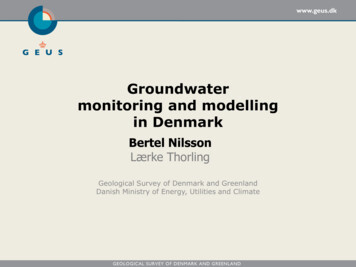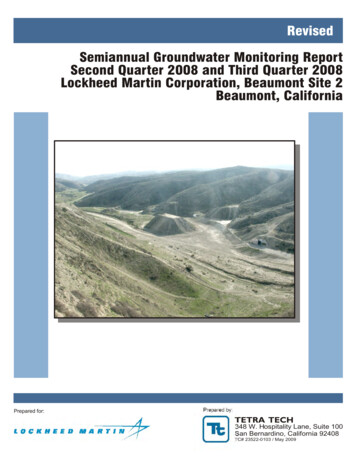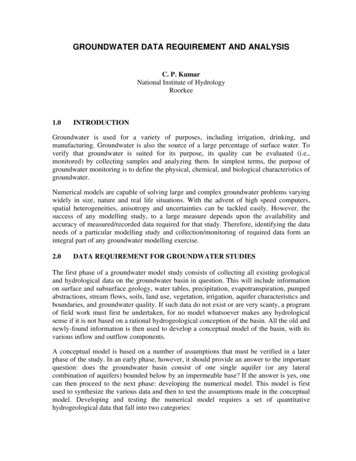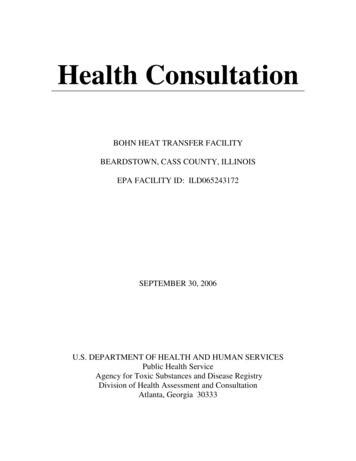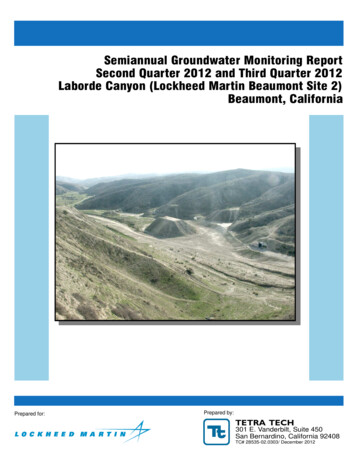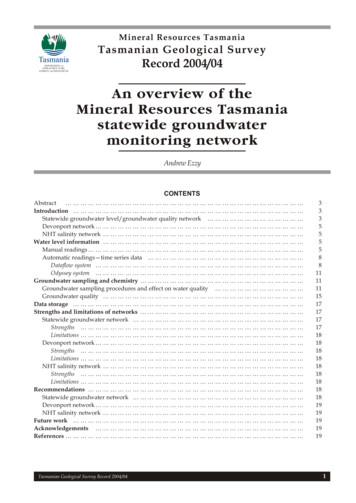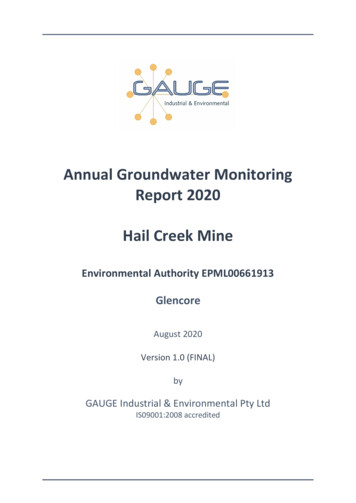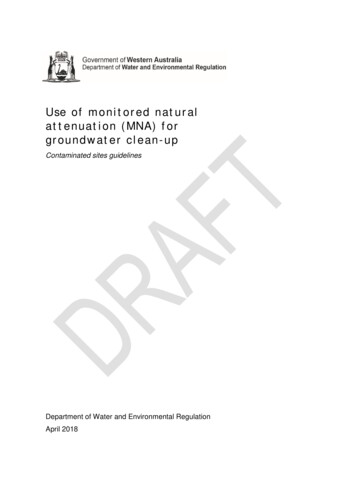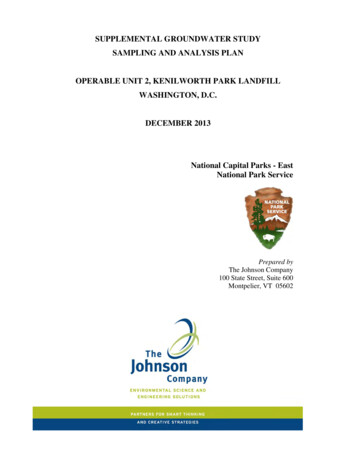
Transcription
SUPPLEMENTAL GROUNDWATER STUDYSAMPLING AND ANALYSIS PLANOPERABLE UNIT 2, KENILWORTH PARK LANDFILLWASHINGTON, D.C.DECEMBER 2013National Capital Parks - EastNational Park ServicePrepared byThe Johnson Company100 State Street, Suite 600Montpelier, VT 05602
Title: Supplemental Groundwater Study SAPSite Name: OU2 Kenilworth Park LandfillSite Location: Northeast Washington, D.C.Revision Date: 12/6/2013Page: iTABLE OF CONTENTS1.0 INTRODUCTION. 11.1 PURPOSE . 21.2 DOCUMENT ORGANIZATION. 22.0 SITE DESCRIPTION. 32.1 PREVIOUS WASTE DISPOSAL INFORMATION. 32.2 SURFACE WATER HYDROLOGY . 42.3 REGIONAL AND SITE GEOLOGY . 62.4 CURRENT GROUNDWATER MONITORING SYSTEM . 72.5 PREVIOUS GROUNDWATER ANALYTICAL RESULTS . 103.0 DATA QUALITY OBJECTIVES . 123.1 STEP 1 – STATE THE PROBLEM . 133.2 STEP 2 – IDENTIFY THE DECISION(S) OF THE STUDY . 133.3 STEP 3 – IDENTIFY INPUTS TO DECISION(S) . 143.4 STEP 4 – IDENTIFY THE BOUNDARIES OF THE STUDY . 153.4.1Spatial Boundaries . 153.4.2Temporal Boundaries. 153.5 STEP 5 – DEVELOP THE ANALYTICAL APPROACH . 163.6 STEP 6 – SPECIFY PERFORMANCE OR ACCEPTANCE CRITERIA . 173.6.1Adherence to Standard Operating Procedures . 173.6.2Completion of the Entire Sampling Plan . 173.6.3Adequate Analytical Detection Limits . 173.7 STEP 7 – DEVELOP THE PLAN FOR OBTAINING THE DATA . 184.0 OVERVIEW OF FIELD ACTIVITIES. 184.1 GENERAL . 184.1.1Project Data Needs . 184.1.2Major Project Tasks. 194.2 PROJECT NARRATIVE . 204.2.1Aqueous Sample Analysis . 204.2.2Piezometers and Staff Gauges . 214.2.3Groundwater Monitoring Wells . 234.3 PROPOSED INVESTIGATION SUMMARY . 265.0 REFERENCES. 29LIST OF FIGURESFigure 1Figure 2Figure 3aFigure 3bFigure 3cFigure 4Figure 5Site Location Map (Historical Basemap)Aerial Photograph of Site and VicinityHistorical Layout, 1894 Topographic MapHistorical Layout, 1949 and 1963 Aerial PhotographsHistorical Layout, 1968 and 1984 Aerial PhotographsExisting Groundwater Monitoring WellsPrevious Water Table Equipotential Maps
Title: Supplemental Groundwater Study SAPSite Name: OU2 Kenilworth Park LandfillSite Location: Northeast Washington, D.C.Figure 6Revision Date: 12/6/2013Page: iiProposed Groundwater Monitoring Wells and PiezometersLIST OF TABLESTables in Text:Text Table 4.2.1 Groundwater Analyses . 20Text Table 4.2.2 Proposed Piezometer Locations . 22Text Table 4.2.3 Proposed Monitoring Well Locations . 24Text Table 4.3 Summary of Investigation Monitoring Installations and Sampling . 27Tables in Attachment:Table 1Existing Monitoring Well DetailsTable 2Historical Groundwater Data – Metals (micrograms per liter, µg/L)Table 3Historical Groundwater Data – VOCs (micrograms per liter, µg/L)Table 4Historical Groundwater Data – Pesticides and PCBs (micrograms per liter, µg/L)Table 5Historical Groundwater Data – SVOCs and TPH (micrograms per liter, µg/L)Table 6Data Quality Objectives Summary TableLIST OF APPENDICESAppendix AAppendix BSupplemental Groundwater Study Field Sampling Plan (FSP)Supplemental Groundwater Study Quality Assurance Project Plan (QAPP)
Title: Supplemental Groundwater Study SAPSite Name: OU2 Kenilworth Park LandfillSite Location: Northeast Washington, D.C.Revision Date: 12/6/2013Page: iiiABBREVIATIONS AND EDDOHDEHPDQODROE&E UOUPAHPA/SIPCBPRGPSQQAPPQA/QCRCRARIRGSVOCTBCAbove mean sea levelApplicable or Relevant and Appropriate RequirementBelow ground surfaceHexachlorocyclohexaneComprehensive Environmental Response, Compensation, and Liability ActCode of Federal RegulationsCubic feet per secondCentimeters per secondDistrict of ColumbiaDistrict of Columbia Sports and Entertainment CommissionDistrict of Columbia Department of the EnvironmentDistrict of Columbia Department of Healthbis(2-Ethylhexyl)phthalate or di(2-ethylhexyl)phthalateData quality objectiveDiesel range organicsEcology & Environment, Inc.Degrees FahrenheitFeasibility StudyField Sampling PlanHealth and Safety PlanIowa State UniversityThe Johnson Company, Inc.Kenilworth Park NorthKenilworth Park SouthMaryland Geological SurveyMicrograms per literNational Capital Parks-EastNational Oil and Hazardous Substances Pollution Contingency PlanNational Oceanic and Atmospheric AdministrationNational Park ServiceNational Resource Conservation ServiceNephelometric Turbidity UnitsOperable UnitPolycyclic aromatic hydrocarbonPreliminary Assessment/Site InspectionPolychlorinated biphenylPreliminary remediation goalPrinciple study questionQuality Assurance Project PlanQuality assurance/quality controlResource Conservation and Recovery ActRemedial InvestigationRemediation goalSemi-volatile organic compoundTo be considered
Title: Supplemental Groundwater Study SAPSite Name: OU2 Kenilworth Park LandfillSite Location: Northeast Washington, D.C.TCLPTPHUSEPAUSFWSUSGSUSTVOCToxicity characteristic leaching procedureTotal petroleum hydrocarbonsUnited States Environmental Protection AgencyUnited States Fish and Wildlife ServiceUnited States Geological SurveyUnderground storage tankVolatile organic compoundRevision Date: 12/6/2013Page: iv
Title: Supplemental Groundwater Study SAPSite Name: OU2 Kenilworth Park LandfillSite Location: Northeast Washington, D.C.Revision Date: 12/6/2013Page: 11.0 INTRODUCTIONThe National Park Service (NPS) is the lead agency for the Kenilworth Park Landfill Site(Site) in the Anacostia Park unit of National Capital Parks-East in Washington, D.C. (Figure 1).The Site covers 130 acres, including the former Kenilworth Park Landfill North (KPN) andKenilworth Park Landfill South (KPS) bisected by Watts Branch, a tributary to the AnacostiaRiver (Figure 2). The Site includes two operable units (OUs): OU1 comprises surface soils andsubsurface soils, including waste material disposed of in KPN and KPS; OU2 includes shallowgroundwater underlying OU1. Two Preliminary Assessment/Site Inspections (PA/SIs), twoRemedial Investigations (RIs) (one each for KPN and KPS), and one Feasibility Study (FS) forOU1 (KPN and KPS combined) have been completed by NPS (E & E 2000a; E & E 2000; E & E2007; E & E 2008; JCO 2012).Given the cap covering the former landfill and existing Site data, groundwater transport isthe only potential pathway for Site contaminants to migrate to adjacent water bodies, andgroundwater data collected during the RIs do not indicate a significant groundwater transportpathway. The PA/SIs, RIs, and FS preliminarily concluded that Site contaminants are notmigrating in groundwater to the Anacostia River. The most recent groundwater sampling eventat the Site occurred approximately 7 years ago. The supplemental groundwater study describedin this Sampling and Analysis Plan (SAP) will supplement existing groundwater data by: 1) moreaccurately determining groundwater gradients and flow patterns at the Site; and 2) providingadditional subsurface data to evaluate whether dissolved contaminants exist at the Site’sgroundwater discharge boundaries bordering the Anacostia River and the Kenilworth Marsh.The results of this SAP will be used to develop an OU2 RI Addendum. Depending on thefindings, the RI Addendum will be used to support the existing Proposed Plan or serve as thebasis for development, evaluation, and selection of a response action for OU2.NPS will implement and document the results of the supplemental groundwater study inaccordance with the Comprehensive Environmental Response, Compensation, and Liability Act
Title: Supplemental Groundwater Study SAPSite Name: OU2 Kenilworth Park LandfillSite Location: Northeast Washington, D.C.Revision Date: 12/6/2013Page: 2(CERCLA), the National Oil and Hazardous Substances Pollution Contingency Plan (NCP)40CFR Part 300, and other applicable local, state, and federal laws and regulations.1.1PURPOSEThe purpose of the supplemental groundwater study is to generate data of sufficientquality and quantity to meet the following objectives. Develop a more refined interpretation of the Site groundwater flow paths andconcentrations with a larger monitoring network focused on groundwater discharge to theAnacostia River. This interpretation will be used to produce a more detailed water tablepotentiometric map that illustrates the water table surface and groundwater flow directionstoward groundwater discharge boundaries including the Anacostia River, KenilworthMarsh, and Watts Branch. More precisely delineate the groundwater chemistry migrating from KPN and KPS to theprimary groundwater/surface water discharge boundaries of the Site at the Anacostia Riverand Kenilworth Marsh to determine whether hazardous substances are potentiallymigrating into the Anacostia River.1.2DOCUMENT ORGANIZATIONThe SAP includes this introduction (Section 1), a brief description of the Site andprevious groundwater investigations (Section 2), data quality objectives (DQOs) (Section 3), adescription of the field activities (Section 4), and references (Section 5).Details of the proposed investigation methodology are presented in the Field SamplingPlan (FSP) (Appendix A), and the Quality Assurance Project Plan (QAPP) (Appendix B). TheFSP presents detailed descriptions of field activities and procedures. The QAPP details theanalytical methods and detection limits required, field and laboratory quality assurance/qualitycontrol (QA/QC) protocols, data assessment procedures for the evaluation and identification ofdata limitations, and preparation of the database and data summaries.
Title: Supplemental Groundwater Study SAPSite Name: OU2 Kenilworth Park LandfillSite Location: Northeast Washington, D.C.Revision Date: 12/6/2013Page: 3A project-specific JCO Site Safety and Health Plan (SSHP) (under separate cover)provides the detailed health and safety procedures that will be employed by The JohnsonCompany throughout the supplemental groundwater study.2.0 SITE DESCRIPTIONEnvironmental investigations have been performed at the Site since 1998. Althoughprevious investigations comprehensively investigated the nature and extent of contaminants inthe landfill and cover soils, the focus of this section is a summary of the information related togroundwater contaminant migration at the groundwater/surface water discharge boundaries to theAnacostia River. The RIs provide detailed descriptions of the Site, including the history ofoperations at the Site that resulted in the current contamination of Site soils and groundwater (E& E 2007; E & E 2008).The following Site description summarizes waste disposal information and describesexisting knowledge related to Site groundwater contaminant migration to the Anacostia River.2.1PREVIOUS WASTE DISPOSAL INFORMATIONThe Kenilworth Landfill received municipal waste and incinerator ash. KPN operatedfrom 1942 until 1970. Soil borings at KPN have encountered the following materials in thelandfill waste: burned combustible materials, brick, glass, rubble, construction debris, metal 1,wood, plastic, and incinerator ash. KPS was permitted in 1958 for waste disposal and usedprimarily after 1968, when burning was prohibited (E & E 2007). Boring logs from monitoringwells installed at KPS describe landfill wastes including glass, paper, wood, metal, concrete, ash,leather, and plastic. In the log for one boring (MW13, located at the southern end of KPS), thesmell of diesel in a soil core was recorded (E & E 2008).1During the 2006 regrading and filling activities by the District of Columbia Sports and Entertainment Commission(DCSEC) in the eastern side of KPN, a “thermos” sized unexploded ordnance (munitions shell) was unearthed by aconstruction worker (JCO 2012). The ordnance was removed from the Site and destroyed by the US Army Corps ofEngineers; no other ordnances have been reported at the landfill and no historical activities at the Site are known tohave been the source of the ordnance (JCO 2012).
Title: Supplemental Groundwater Study SAPSite Name: OU2 Kenilworth Park LandfillSite Location: Northeast Washington, D.C.Revision Date: 12/6/2013Page: 4There are approximately 3.5 million tons of waste in the landfill at KPN and KPS,including incinerator ash, waste that was burned in-place, and unburned municipal solid waste(JCO 2012). A cap of approximately 3 to 15 feet (the greater thickness is on the eastern side ofKPN) of primarily clayey materials was placed on top of the KPN landfill when it ceasedoperations, and the soil was amended using sewage sludge to establish grass (E & E 2007). TheKPS landfill was initially capped when the landfill was closed around 1970, and additionalcapping occurred in 1997 and 1998; the resulting cap thickness at KPS ranges from 2 to morethan 20 feet, with the thickest cap on the western side of KPS (E & E 2008).2.2SURFACE WATER HYDROLOGYThe most significant surface water feature associated with and bordering the Site is theAnacostia River (Figure 1), which typically flows from north to south along the westernboundary of the Site, although tidal influences can affect the flow direction. A water stagerecorder that registers tidal elevations every 6 minutes is located on the Anacostia Riverapproximately 77.5 feet upstream of the tidal inlet to Kenilworth Marsh (USGS 2012), which isapproximately 1,000 feet north of the northern edge of KPN. From November 1 to 15, 2012,tidal elevations ranged from -2.1 feet above mean sea level (amsl) at low tide to 2.95 feet amslat high tide, with a maximum single day difference of 4.34 feet. On average, a 3.0 foot tidalexchange occurs twice daily at the Kenilworth Marsh (NPS 2011), although major storm eventsincluding the 2012 storm Sandy have increased maximum high tide elevations to close to 5 feetamsl at this gauging station (USGS 2012). A segment of seawall eligible for inclusion on theNational Register of Historic Places is located along the Anacostia River bank approximatelybetween MW-6N and MW-7N at KPN (Figure 4), but is not present at KPS.The majority of the Site is mapped as a known wetland, called “Kenilworth AquaticGardens,” by the District of Columbia Department of Health (DDOH) (DDOH 2012), but thereare no wetlands identified at the Site in the National Wetlands Inventory (USFWS 2012). The77-acre Kenilworth Marsh, located at the northern edge of the landfill at KPN, was dredged tocreate a lake in 1940, then reconstructed as a wetland in 1993 by the Army Corps of Engineers,and has been managed as a wetland since then by the National Capital Parks-East (NACE) unit
Title: Supplemental Groundwater Study SAPSite Name: OU2 Kenilworth Park LandfillSite Location: Northeast Washington, D.C.Revision Date: 12/6/2013Page: 5of NPS (Syphax and Hammerschlag 1995; USGS 2008). Dredge spoils from the AnacostiaRiver were used as fill to reconstruct the Kenilworth Marsh wetland (Syphax and Hammerschlag1995).The Watts Branch stream flows through the Site between KPN and KPS to the AnacostiaRiver. The Watts Branch has been characterized as “one of the largest tributaries to theAnacostia River located within D.C. boundaries” (USFWS 2002). The reach of Watts Branchthat parallels the northern side of Mayfair Mansions and Paradise Apartments (the formerBenning Race Course) was shown as channelized as long ago as 1894, as shown on Figure 3a 2.More recent aerial photographs in Figures 3b and 3c show the Watts Branch channel extended toflow around Mayfair Mansions and Paradise Apartments, discharging directly to the AnacostiaRiver. The U.S. Fish and Wildlife Service (USFWS) identified 41 stormwater outfalls and 13stormwater pipe/box culvert combinations that discharge into the D.C. portion of Watts Branch.The channelized upper and lower reaches of Watts Branch receive flows from numerous stormsewers, resulting in poor instream habitat ratings for all reaches, primarily caused by“hydrocarbons, heavy metals, pesticides, sewage, and sediment” (USFWS 2002). Recently, themoney generated from the DC bag tax was used to restore 1.8 miles of this watershed. Therestoration design included structures that create instream habitat and reduce flood stresses onchannel banks, while riparian vegetation provides bank stability and wildlife habitat.The United States Geological Survey (USGS) maintains a stage recorder in the WattsBranch at a location approximately 3,000 feet upstream of the southern border of KPS,approximately 10 feet upstream of the Minnesota Avenue bridge (USGS 2013). Between 1993and 2011, measured discharge in the Watts Branch has ranged from 0.58 to 130 cubic feet persecond (cfs), but average annual discharge values over these recorded years have ranged from1.76 to 7.25 cfs (USGS 2013).2The difference in channel locations between today’s mapping and the 1894 map are likely a result of scaledifferences, not channel movement.
Title: Supplemental Groundwater Study SAPSite Name: OU2 Kenilworth Park LandfillSite Location: Northeast Washington, D.C.Revision Date: 12/6/2013Page: 6There is an unnamed southern tributary to Watts Branch located outside the easternboundary of KPS (Figure 4). This tributary reportedly originates in storm drains in the vicinityof Grant Street and previously drained to a constructed silt pond (E & E 2000), but currentlydischarges into Watts Branch.2.3REGIONAL AND SITE GEOLOGYThe Site is located within the Atlantic Coastal Plain physiographic province, which isunderlain by a wedge-shaped sequence of sandstones, clay beds, gravel deposits, and silts thatincreases in thickness from west to east (NPS 2008). The Fall Line, at which the wedge ofCoastal Plain sediments is thinnest, is located approximately 4 miles west of the Site. ArundelClay (dark grey and maroon lignitic clay) is the dominant Coastal Plain sediment at the Site, butthe Patapsco formation (gray, brown, and red variegated silts and clays with sand and minorgravels) may also be present above the Arundel Clay (MGS 1968). No deep boring logs fromthe Site are available for review, but a well log from the National Arboretum recorded thethickness of Arundel Clay at approximately 100 feet. Because the Arboretum is located on thewestern bank of the Anacostia River near the Site, a similar thickness could be expected at theSite.The Site is shown on the NACE geologic map as being in an area of disturbed groundand artificial fill, surrounded by alluvial surficial deposits (NPS 2008). A geologic map from1958, which pre-dates the landfill, shows that the Site was covered by the Pamlico Formationand recent alluvium, which is composed of gravel, sand, and silt (including artificial fill) (USGS1958).According to cross-sections presented in the KPN RI report, the thickness of landfillwaste at KPN varies from approximately 10 feet to 30 feet, with the thickest layer located in thenorthwestern portion of the property (E & E 2007). Although there were no borings at KPS thatwere advanced to the bottom of the waste except at the edges, the maximum waste thickness hasbeen estimated at approximately 20 feet near the center of the landfill (E & E 2008).
Title: Supplemental Groundwater Study SAPSite Name: OU2 Kenilworth Park LandfillSite Location: Northeast Washington, D.C.Revision Date: 12/6/2013Page: 7Based on drilling logs from previous investigations at KPN and KPS, the landfill waste atthe Site has a soil cover composed of silty clay and silty loam of unknown origin, and the wasteis composed of gravel, ash, sand, silt, clay, glass, metal, and rubber. Throughout KPS and in thesouthwestern portion of KPN, brown silty clay was recorded immediately beneath the waste,underlain by soft, wet, plastic clay. At the eastern side of KPN, a layer of sand and gravelapproximately 10 feet thick was recorded between the waste and Arundel Clay (tough, red andcream clay) at the two easternmost wells, but the gravel was only recorded as a thin layer in theborings to the west.2.4CURRENT GROUNDWATER MONITORING SYSTEMThe existing groundwater monitoring system is evaluated in this section with respect tothe current information available for the purpose of designing a supplemental groundwater study.The existing monitoring system will be refined to thoroughly evaluate groundwater dischargefrom the Site to the Anacostia River and Kenilworth Marsh.A total of 29 wells have been installed at the Site, as follows and shown in Figure 4: 16 wells at KPN (the suffix “R” indicates that the well is a replacement of anolder well) - MW1N, MW-2N, MW-3NR, MW-4N, MW-5N, MW-6N, MW-7N,MW-8NR, MW-9NR, MW-10N, MW-11N, MW-12N, MW-13N, MW-14N,MW-15N, and MW-16N; and 13 wells at KPS - MW1 through MW13.All wells were installed between 1998 and 2008 during investigations by Ecology andEnvironment (E & E). The boring and well installation logs are included in the KPN and KPSRI reports (E & E 2007; E & E 2008). One monitoring well, MW-11N, is located upgradient ofthe landfill in the northeastern corner of KPN. MW1 through MW6 at KPS were installed inhand-augered holes along the banks of Watts Branch and the Anacostia River. All other wellswere installed by a hollow-stem auger, and soils were retrieved in split spoons at irregularintervals; thus, no continuous cores were collected or observed. Although there is a stream
Title: Supplemental Groundwater Study SAPSite Name: OU2 Kenilworth Park LandfillSite Location: Northeast Washington, D.C.Revision Date: 12/6/2013Page: 8gauge on the Watts Branch located at Minnesota Avenue, outside the Site, there have been nocontemporaneous measurements of the stream gauge and monitoring wells.Based on boring logs or other statements in the RI reports, the following interpretationsof monitoring well screen (i.e., groundwater intake) depths and locations relative to theobjectives of the supplemental groundwater study are provided: 13 well screens are installed outside of or below landfill wastes including 6 atKPS (MW1 through MW6), and 7 at KPN (MW-1N, MW-3NR, MW-11N, MW12N, MW-14N through MW-16N); 12 well screens are installed within landfill wastes including 5 at KPS (MW8,MW9, and MW11 through MW13), and 7 at KPN (MW-2N, MW-4N, MW-7N,MW-8N, MW-9NR, MW-10N, and MW-13N); 4 well screens may be in landfill wastes, i.e., boring logs are imprecise, including2 at KPS (MW7 and MW10) and 2 at KPN (MW-5N and MW-6N); and approximately 12 of these 29 wells are located along likely groundwaterdischarge boundaries to the Anacostia River and Kenilworth Marsh relative to thedowngradient flow direction from the landfill at KPS and KPN.Based on water table maps and estimated groundwater flow direction maps presented inthe RI reports (see Figure 5), the shallow groundwater table is mounded under both KPN andKPS as a result of the landfills and groundwater primarily migrates toward the topographic lowdischarge areas at Kenilworth Marsh and the Anacostia River. Portions of the Watts Branchcould also influence groundwater flow directions, but the degree of impact cannot be determinedby existing data; Watts Branch surface water elevation measurements relative to groundwaterelevations were not collected. The maximum groundwater elevation measured at MW-8 near thetop and center of KPS was approximately 8 feet higher than the maximum groundwater elevationat KPN, near the northwestern edge of the landfill at MW-5N.
Title: Supplemental Groundwater Study SAPSite Name: OU2 Kenilworth Park LandfillSite Location: Northeast Washington, D.C.Revision Date: 12/6/2013Page: 9Slug tests were performed to estimate hydraulic conductivities in all monitoring wellsexcept MW-9 at KPS. The hydraulic conductivities at KPS ranged from 2 x 10-6 to 2 x 10-5centimeters per second (cm/s) except at wells MW12 and MW13, which were tested at a laterdate and had higher hydraulic conductivities of 3 x 10-3 and 6 x 10-3 cm/s. Hydraulicconductivity values at KPN varied by more than three orders of magnitude from 2 x 10-6 to 3 x10-3cm/s, although eight of the twelve wells tested had results ranging from 1 x 10-4 to 6 x 10-4.Accurate average hydraulic conductivity values for specific subsurface units cannot be calculatedusing the existing well screen locations given the large variability of geologic units and landfillwastes intersected by the well screens. However, the most common lower hydraulicconductivity values are representative of the silty clay material commonly logged beneathlandfill wastes. The supplemental groundwater monitoring system will provide additionalhydraulic conductivity measurements from slug test in new wells screens installed relative tomore precise geologic logging.Depth to the groundwater table was measured and recorded in June of 2001 at KPS, inMarch of 2006 at KPN, and in December of 2012 at both KPN and KPS. A comparison of waterlevels between June of 2001 and December of 2012 at KPS indicates no seasonal trend, withsome levels higher and some lower. At KPN, water levels in March of 2006 were an average of0.67 feet higher than in December.Tidal influence studies, intended to evaluate whether water levels in Site monitoringwells are affected by the tides in the Anacostia River, were performed at KPS in June of 2001and at KPN in March of 2006. The following two monitoring wells were chosen for the tidalinfluence study at KPS: MW6, located adjacent to Watts Branch approximately 500 feet fromthe Anacostia River bank; and MW10, located at the eastern edge of KPS, approximately 1,250feet from the Anacostia River. The MW10 water levels were intended to provide a baseline ofbarometric pressure effects to compare to the MW6 water levels. The water levels weresupposed to be recorded for 12 hours, but the transducer in MW6 malfunctioned forapproximately 3 of these hours. No tidal effect was measured in MW10. In MW6, the results
Title: Supplemental Groundwater Study SAPSite Name: OU2 Kenilworth Park LandfillSite Location: Northeast Washington, D.C.Revision Date: 12/6/2013Page: 10indicated a minimal water level change: the Anacostia River level changed by approximately 36inches (3 feet) while the groundwater level in MW6 changed approximately 4.1 inches indicatinga “tidal efficiency” of 4.1 inches/36 inches, or 11 percent. The tidal response was calculated tohave been delayed by approximately 9 hours. Based on the tidal efficiency and the delayedresponse, E & E concluded that “the well is not reached by surface water recharging the streambank during the tidal cycle, and well water reflects the quality of groundwater discharging fromthe Site” (E & E 2008). E & E also concluded that as a result of the relatively low hydraulicconductivity values (averaging 1 x 10-5 cm/s) at the monitoring wells along the Anacostia Riverand Watts Branch (MW1 through MW5), these wells would respond similarly to MW6, althoughnone of these wells were monitored.The tidal influence study at KPN was performed using a different approach than at KPS.Pressure transducers and data loggers were installed at five wells at KPN (MW-4N, MW-5N,MW-6N, MW-7N, and MW-15N), and the change in groundwater levels and Anacostia Riversurface water levels was recorded for 24 hours. During this time, the Anacostia River levelvaried between approximately 0.25 feet amsl to 3 feet amsl, while the water levels in all fiveKPN monitoring wells varied less than 0.01 foot. E & E concluded, “it appears that there is notidal influence on groundwater at the landfill and that the Anacostia River does not appear tohave a hydrologic connection to the KPN landfill. Apparently flow is only from the landfill tothe river and [there is] no flow from the river into the landfill wel
The purpose of the supplemental groundwater study is to generate data of sufficient quality and quantity to meet the following objectives. Develop a more refined interpretation of the Site groundwater flow paths and concentrations with a larger monitoring network focused on groundwater discharge to the Anacostia River.
